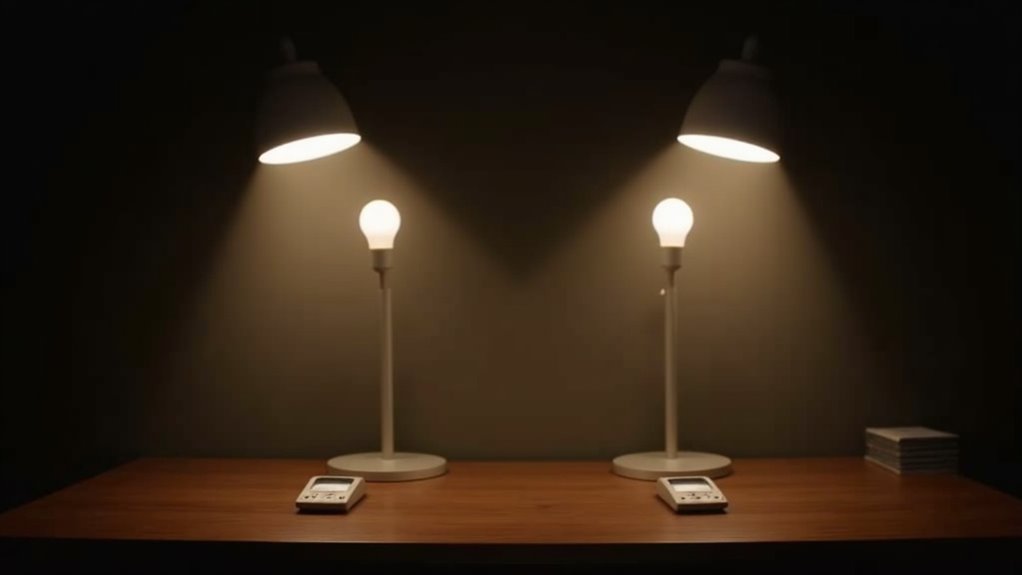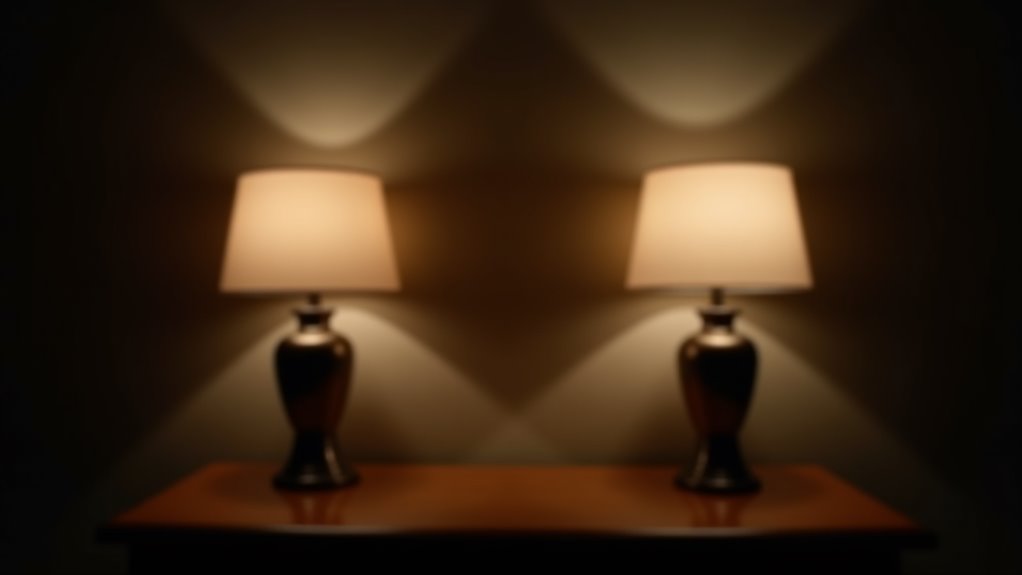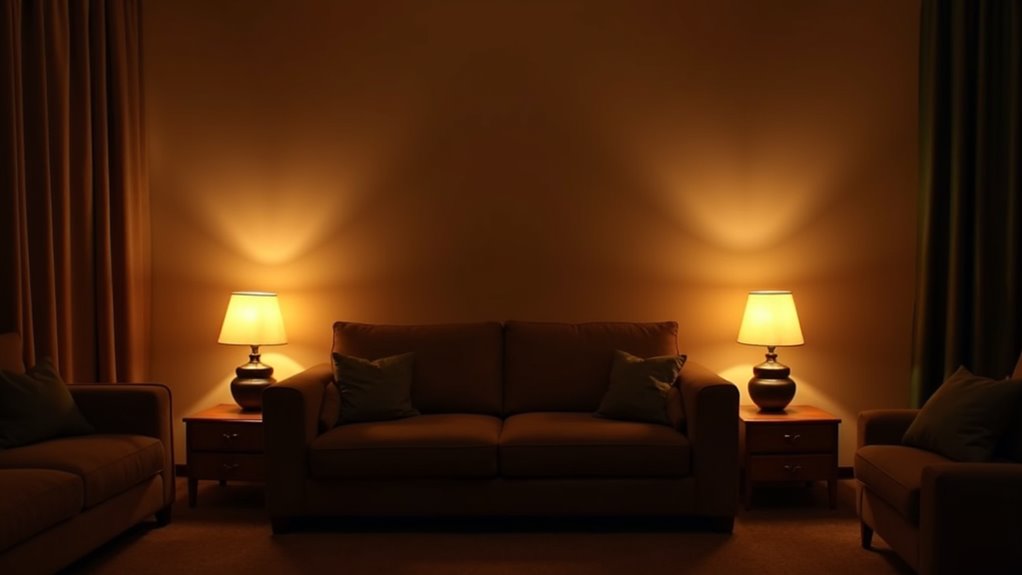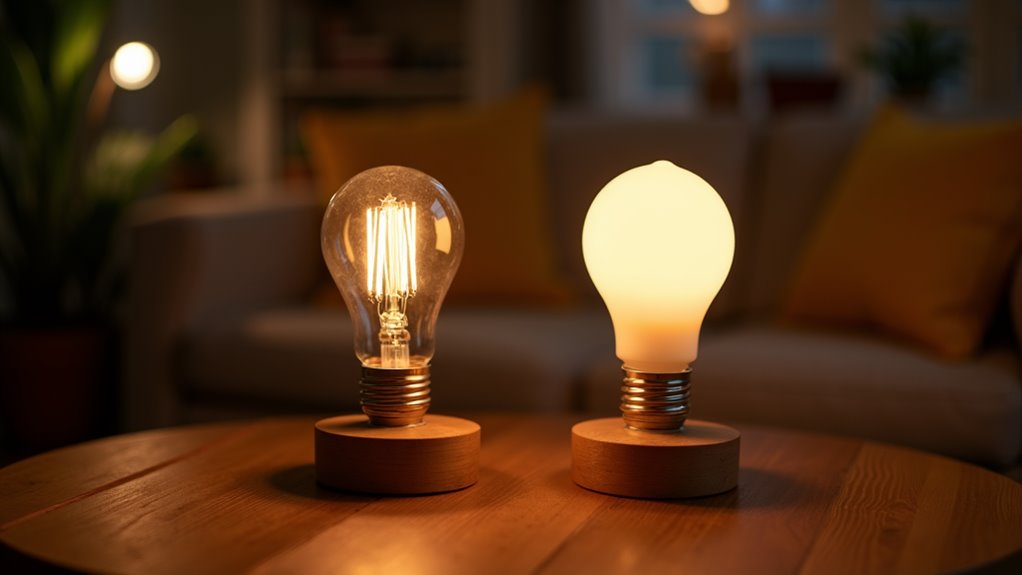Clear light bulbs generally produce 3-5% more lumens than frosted bulbs at the same wattage, making them brighter in terms of raw light intensity. The enhanced lumen output of clear bulbs results in focused beams, ideal for tasks requiring high brightness. In contrast, frosted bulbs offer softer, diffused light, minimizing glare and harsh shadows. The selection of bulb type depends on the desired ambiance and application, which can significantly affect overall lighting quality. Discover more insights into choosing the perfect bulb for your needs.
Key Takeaways
- Clear bulbs produce 3-5% more lumen output than frosted bulbs at the same wattage.
- Frosted bulbs diffuse light, creating a softer illumination but slightly reducing brightness.
- Clear bulbs focus light better, making them ideal for task lighting and precision activities.
- Frosted bulbs minimize glare, enhancing eye comfort in general living spaces.
- The choice between clear and frosted bulbs depends on the desired ambiance and intended application of the lighting.
Understanding Lumens and Brightness

Lumens serve as a crucial measurement in understanding light output from various sources, particularly in the context of home lighting. The lumen definition quantifies the total amount of visible light emitted by a light source, offering an objective standard by which brightness can be assessed. Unlike lumens, brightness perception is subjective, influenced by factors such as room size, surface reflectivity, and color temperature. Historically, consumers relied on wattage to gauge brightness, but lumens provide a more accurate assessment of a bulb’s light output. For example, an energy-efficient 6.5W LED can yield similar lumens to a traditional 50W halogen bulb, demonstrating the importance of considering lumens over watts when selecting lighting to achieve desired brightness levels in various spaces. This shift towards higher lumen ratings also means that consumers can enjoy brighter lighting solutions with lower energy consumption. Additionally, understanding lumen requirements in specific environments helps ensure optimal lighting for each unique space.
The Effect of Frosting on Light Output

Frosting significantly influences the light output and quality of a bulb, primarily through its light diffusion mechanism. Various frosting techniques, such as sandblasting or acid etching, render the glass translucent, scattering light and reducing glare from the filament.
This results in softer, more even illumination, contributing to a comfortable viewing experience. While frosted bulbs may experience a slight reduction in lumen output—typically 3-5%—the diffusion effects create a more pleasant and soothing glow, enhancing overall ambiance.
Additionally, frosted lenses effectively minimize harsh shadows and glare, making them preferable in settings where prolonged exposure occurs. Overall, the primary function of frosting is to enhance light quality rather than simply reduce brightness.
Clear Bulbs vs. Frosted Bulbs: A Brightness Comparison

When comparing clear bulbs to frosted bulbs, one key consideration is their relative brightness and light distribution.
Clear bulbs typically produce 3-5% higher lumen output than frosted bulbs at the same wattage, as their clear lenses allow more light to pass through without diffusion. For example, a 40W clear incandescent bulb generates about 400 lumens, while its frosted counterpart yields approximately 350 lumens.
Clear bulbs emit 3-5% more light than frosted bulbs, making them ideal for focused brightness.
Furthermore, clear bulbs provide a focused and intense beam, ideal for task lighting, while frosted bulbs diffuse light, creating a softer, more uniform distribution suitable for general illumination.
Ultimately, the choice between clear and frosted bulbs depends on specific lighting needs, balancing the desire for intensity against the comfort of softer light.
Perceived Brightness and Glare in Lighting

The perceived brightness and glare of light bulbs play a critical role in influencing visual comfort and performance.
Clear light bulbs typically produce higher glare due to their direct light distribution and lack of diffusion, while frosted bulbs offer a softer light quality that mitigates harsh shadows and glare.
Eye comfort considerations further highlight the importance of bulb choice in creating optimal lighting environments, impacting both well-being and productivity.
Glare Characteristics of Bulbs
Glare characteristics of light bulbs play a crucial role in determining the perceived brightness and comfort of a space. Clear bulbs emit intense, focused light, increasing glare perception and discomfort, especially when viewed directly. In contrast, frosted bulbs diffuse light, resulting in softer illumination and reduced glare sources, making them preferable for enhancing overall comfort.
| Bulb Type | Glare Potential | Application |
|---|---|---|
| Clear | High | Decorative fixtures, task lighting |
| Frosted | Low | General room illumination |
| Ambient lighting | ||
| Spaces needing softer light | ||
| Offices, bedrooms |
Mitigating glare involves fixture design, bulb placement, and utilizing shielding techniques to enhance visual comfort.
Shadow Quality Comparison
Shadow quality significantly influences perceived brightness and overall ambiance in various lighting environments. Clear bulbs produce shadows with high clarity due to their direct light paths, resulting in defined edges and sharper transitions. This stark shadow contrast contributes to a brighter appearance in illuminated areas.
Conversely, frosted bulbs employ light diffusion, softening shadow edges and promoting more gradual transitions. The pronounced penumbra effect with frosted bulbs minimizes visual distractions while creating a more uniform lighting atmosphere.
While clear bulbs enhance detail with their crisp shadows, they can lead to visual fatigue in ambient settings. Therefore, for general illumination, frosted bulbs may be preferable, as they provide gentler shadows that contribute to a more inviting and spacious environment.
Eye Comfort Considerations
In various lighting applications, eye comfort is significantly affected by perceived brightness and glare, which are influenced by the type of light bulb used.
- Clear bulbs emit direct light, increasing the potential for glare, which can cause eye fatigue and discomfort.
- Frosted bulbs diffuse light, reducing glare and creating a more comfortable lighting ambience.
- Lumen output from clear bulbs may be higher, yet this does not always translate to improved comfort due to glare.
- Proper diffusion from frosted bulbs minimizes harsh contrasts, allowing for smoother luminance distribution.
Applications for Clear and Frosted Bulbs

Clear and frosted bulbs serve distinct functions based on their design characteristics, influencing their applications in various settings.
Clear bulbs excel in decorative fixtures, where their filament can enhance visual appeal, while also providing focused illumination for task-oriented environments.
Conversely, frosted bulbs are preferred for general illumination tasks, offering diffused lighting that reduces glare and enhances overall comfort in living and working spaces.
Decorative Fixture Preferences
Decorative fixture preferences often hinge on the choice between clear and frosted light bulbs, each offering distinct advantages tailored to different aesthetic and functional requirements.
- Clear bulbs enhance decorative fixture styles by showcasing unique filament designs, maximizing brightness, and creating eye-catching statements, particularly in modern and industrial settings.
- Frosted bulbs provide a softer, diffused illumination, reducing glare and shadows, making them ideal for creating cozy atmospheres in spaces like bedrooms and living areas.
- Exposed bulb fixtures favor clear bulbs for their crisp light quality and visual sparkle, emphasizing the bulb’s design.
- Shaded fixtures typically recommend frosted bulbs to achieve even light distribution and minimize glare, contributing to a warm ambiance.
General Illumination Uses
The choice between clear and frosted light bulbs extends beyond aesthetics, significantly influencing general illumination applications in various environments.
Frosted bulbs offer distinct benefits, such as glare reduction and even light distribution, making them ideal for living spaces where visual comfort is critical. Their soft, ambient light contributes to a relaxed atmosphere, suitable for bedrooms and dining areas.
Conversely, clear bulbs present advantages in applications requiring maximum brightness and focused lighting. They shine in high-ceiling settings and outdoor environments, where bright, direct light enhances visibility and security.
Ultimately, the selection depends on desired ambiance and fixture design, as well as the practical uses of light in different room types.
Task Lighting Considerations
When selecting light bulbs for task lighting, various factors influence the effectiveness and suitability of clear versus frosted bulbs for specific applications. Clear bulbs excel in delivering focused illumination, while frosted bulbs offer comfort and glare reduction. Key considerations include:
- Task Focus: Clear bulbs provide maximum lumen output, ideal for tasks requiring sharp visibility.
- Light Direction: Clear lenses offer undiffused light, suitable for precision work in environments like laboratories.
- Glare Management: Frosted bulbs distribute light evenly, reducing glare in long hours of office workspaces.
- Comfort Level: Frosted bulbs are preferable for reading or studying, minimizing eye strain with softer light.
Ultimately, the choice between clear and frosted hinges on the specific task lighting needs and desired comfort level.
Choosing the Right Bulb for Your Needs

How can one ensure they select the ideal light bulb for their specific needs?
First, it is crucial to evaluate light bulb styles and their respective brightness, measured in lumens, to match the desired ambiance. For warmer tones in living spaces, bulbs within the 2000K-3000K range are preferable, while cooler tones (3100K-6500K) work well in functional areas like kitchens.
Additionally, considering bulb material options, such as LED or CFL, can enhance efficiency and longevity; LEDs are optimal for their low energy consumption and extended lifespan.
Compatibility with fixtures and dimmer switches should also be examined to ensure functionality.



Bài viết cùng chủ đề:
Choosing Title 20 Compliant Light Bulbs for Your Home
Top 3 LED Office Light Bulbs for Bright Workspaces
Top 5 PAR 20 LED Light Bulbs for Home Lighting
What Are Linear Halogen Light Bulbs and How Do They Function?
5 Best Battery-Operated LED Picture Lights for Artwork in 2025